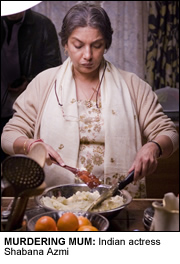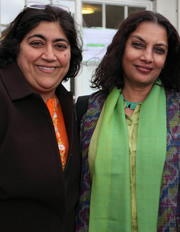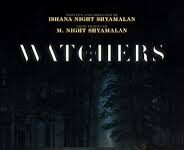Indian star on teaming up with Gurinder Chadha for ‘It’s a Wonderful Afterlife’
 ONE of the leading lights of the Indian New Wave, Shabana Azmi established herself at the forefront of Indian film during the 1970s and 1980s.
ONE of the leading lights of the Indian New Wave, Shabana Azmi established herself at the forefront of Indian film during the 1970s and 1980s.
She has since worked with almost all of India’s most famous arthouse directors — Shyam Benegal, Satyajit Ray, Mrinal Sen, Aparna Sen — as well starring in a string of commercial Bollywood hits. Described by Gurinder Chadha as ‘the Indian Meryl Streep’, she is noted for her naturalness and intensity on-screen, and has, in later years, proved herself a dab hand at comedy. In Gurinder Chadha’s It’s A Wonderful Afterlife she takes the lead as the murderous Mrs Sethi…
Tell me a little about your character in the movie…
I play Mrs Sethi, a widow from Southall, who is very concerned about her daughter getting on in years, and she’s very keen to get her daughter married. She is very heart-broken because her daughter has had so much rejection, down to the fact that she is quite fat. She loves her daughter and is very affronted by the rejection, so she takes rather extreme measures to deal with these people who’ve rejected her daughter. She actually kills them.
That’s quite an extreme reaction, isn’t it?
It is, but these people have been very uncharitable towards her daughter and there is absolutely no conflict in Mrs Sethi’s heart, because she feels that they have been extremely unfair to her daughter, who she feels is an extremely beautiful girl at heart, and they didn’t even give her a chance, or try to get to know her. They just rejected her because of her being fat. And in her head, Mrs Sethi is absolutely clear that this is the right thing to do. She’s completely unprepared, however, for the fact that all these people that she’s killed are going to turn up in the form of spirits around her, and then hound her!
And only Mrs Sethi can see these spirits, right?
Yes, only she can see them, nobody else, so most of the time when she’s talking to them, her daughter thinks that she’s gone bananas. But the spirits say that they need to be liberated, and say that for that to happen, Mrs Sethi has to kill herself, so that the spirits can pass on and have their reincarnation. And eventually she gives in and agrees to do that, but just as she is about to eat the poison she has made to kill herself, there is an interruption, she leaves the food behind and it turns out that her neighbour and best friend, a Jewish woman [played by Zoe Wannamaker], has eaten it and that it has killed her and her dog! So Zoe turns up as another spirit.
How does Mrs Sethi’s relationship with these spirits develop? Presumably they’re furious with her…
To begin with they are absolutely furious, and then over time a relationship develops with them, and by the end, the spirits feel that just by watching Mrs Sethi’s relationship with her daughter, they have learned about several mistakes that they made with their children in their lives, and feel that they are now better people in death than they were in life. And that is really how Mrs Sethi gets absolved.
How do you describe the film when your friends and family ask about it?
Well, it’s wild and whacky, that is for sure. Unusual, mad and totally Gurinder, and it is written with such conviction. The film completely blew my mind; it is very funny, but it is also a love story between the mother and daughter. It’s a film that works with many layers and many levels, and ultimately it is about being able to believe in this completely mad situation. I think that in the script, that has been achieved. It defies your credulity but ultimately you accept it, and if a film can achieve this then it is a winner.
It is an Ealing Comedy in tone; were you familiar with those films, like Blithe Spirit and The Ladykillers?
That was the brief that Gurinder gave to me — that the film was an Ealing Comedy — but that meant nothing to me, because I had no idea what that was!
And did you put on some weight for the role?
I will tell you what, I put on 25lbs for the part, because I had to get physicality right. And having put on that weight, it helped me inhabit the world of Mrs Sethi more easily. But it is a tough thing to do; when you do this with your body it is about losing your vanity and all of that. That was important for me to do.
Was gaining the weight a personal decision, or did Gurinder ask you to do it?
The script asked for it, but I think Gurinder was surprised by how seriously I took it, because Gurinder said that they could use padding, but then I have a slim face, normally, so I’d be caught out. So it is better for me to actually gain the weight, then it’s more proportionate. And there is a very good area in the film when the mother and daughter are trying to lose weight and it is important that both of them are fat, because they look very funny when they’re doing all these exercises and things to try and lose the weight together. So I was convinced about it, that it was something that I needed to do, so I just stuffed my face. Of course, now the film is over, I’m struggling very hard to get the weight off! I’ve done it in the past, and it was a breeze, because I was 20 years younger! Now, 20 years later, it’s very difficult! I’m really grappling with that at the moment.
It must have been difficult inhabiting an English-Indian character; what points of reference did you use?
There were hardly any reference points I could draw from my own life, no, so I went largely guided by Gurinder. It was a huge departure for me. I had been doing some comedy; it seems in India as I’ve got older people they’ve had enough of all my intensity, and that they’d much rather see me in comedy! But compared to the work I am doing in India this is a huge, huge departure for me. The thing is that I have no idea. Normally when I do a film in India, I have a pretty good idea about whether it will work or not, but with this film I have absolutely no idea. I think the success, if it comes, will be totally Gurinder’s, because she has written this completely mad character, Mrs Sethi, and it’s a very difficult thing to do, because there are so few scenes where I am alone, without these four or five spirits around me. That makes the choreography very hard indeed. She had to look at two monitors simultaneously and six people in frame for close-ups. So it must be very harrowing trying to decide which take to use. You’re looking at two cameras and six people together all the time. That’s a challenge for any director, and Gurinder has orchestrated a wonderful thing.
 Did you know Gurinder prior to accepting the part in the film?
Did you know Gurinder prior to accepting the part in the film?
I had met her very briefly at my home when we spoke about the movie, but I did not know her personally, although I had seen her films and enjoyed them very much, so in the beginning there was not great familiarity. But on set she’s a very relaxed person and knows absolutely what she wants, but she is not bossy. There were times she’d come up to me, completely poker-faced, and say, ‘You know that was a terrible take, don’t you?’ and I would burst out laughing and say, ‘Of course.’ And she’d go, ‘Next time, please don’t do it so badly.’ She can be very generous and when she had an issue she told you with such good grace. When you are told straight that you have done a rotten take, you can take it straight on the chin. So we had a very happy relationship, and she would listen to me when I had something to say. It was a feeling of trust, which was very nice. I had a happy relationship with all my co-stars, too. I hadn’t seen much of their work. It’s a different sensibility from which we come, different backgrounds. In Bollywood, things are pretty hierarchical and you are treated as special, whereas here this was far more democratic, like theatre. I think if I had only done Bollywood, it would have been strange, but I have done theatre, which is totally non-hierarchical, so maybe I wasn’t too unsettled. It was nice not to be a big star and have all the attention; I found it quite comforting.
‘It’s a Wonderful Afterlife’ is released in cinemas across the UK on the 21st April 2010.







































